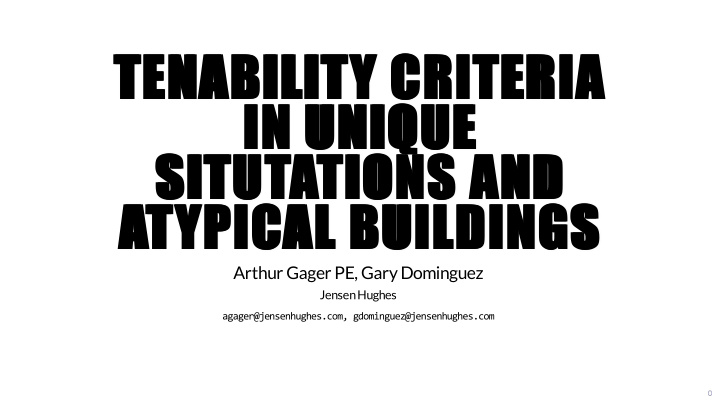



TENABILITY CRITERIA TENABILITY CRITERIA IN UNIQUE IN UNIQUE SITUTATIONS AND SITUTATIONS AND ATYPICAL BUILDINGS ATYPICAL BUILDINGS Arthur Gager PE, Gary Dominguez Jensen Hughes agager@jensenhughes.com, gdominguez@jensenhughes.com
INTRODUCTION Active Smoke Control Systems Smoke Containment Smoke Management Analysis of Smoke Management Systems Algebraic Equations versus CFD
SMOKE CONTROL Smoke control research First successful use of smoke control in after the 1881 Ring 1911 during the Empire Palace Theater Fire in Vienna Theater Fire in Edinburg
Tenability Guides Visibility Temperature Toxicity
VISIBILITY While temperature and toxic gases are the final causes of death, many evacuees are trapped in an early stage of a fire by relatively thin smoke. The presence of smoke in an occupied enclosure obscures illumination from windows and other light sources, so that escaping occupants can find themselves in dimly lit conditions. The threshold of fire smoke density and visibility limits for safe evacuation has been examined by multiple institutions.
VISIBILITY - SIZE OF ENCLOSURE
VISIBILITY - CALCULATIONS Reflecting Sign Proportionality Illuminating Sign Constant = 3 Proportionality Constant = 8 (1) (2)
VISIBILITY - NFPA 130 Smoke obscuration levels should be maintained below the point at which a sign internally illuminated is discernible at 30 meters and doors and walls are discernible at 10 meters.
TEMPERATURE Exposure to heat can lead to incapacitation or death in fire victims in three ways : Hyperthermia Body Surface Burns Respiratory Tract Burns (3) Where: (4)
Temperature - Hyperthermia Hyperthermia involves prolonged exposure to heated environments at temperatures to low to cause burns
Temperature - NFPA 130 Maximum Temperature Exposure Times T able B.2.1.1
TOXICITY Death from smoke inhalation Products of combustion Impacted by type of fuel and conditions where combustion occurs Wide range of effects on occupants Asphyxiants, sensory/ respiratory irritants, toxic
TOXICITY - CO AND HCN CO exposure accounts for the majority of fire fatalities Fractional Effective Dose (FED) is used to address exposure to effluents as a function of time
FRACTIONAL EFFECTIVE DOSE (FED)
TOXICITY - NFPA 130 AEGL 2: General population including susceptible individuals 0.3: More sensitive populations 0.5: Healthy Adult Population
PRISONS 2009 IBC requires specific prison spaces to be provided with a tenable environment for exiting during a fire. Different characteristics compared to atrium and other buildings were smoke control is typically provided. Smaller with shorter travel distances to exits. Controlled items and limited combustibles. Occupants who are familiar with the space but free egress is not the first goal or possible for most.
PRISON LAYOUTS - LARGE CELL BLOCK
DORMATORY AND SINGLE CELLS
PRISON TENABILITY
PRISON TENABILITY
PRISON TENABILITY
AMUSEMENT PARKS Required for enclosed rides by some local jurisdictions in locations with amusement attractions and other stake holders. Occupants can become trapped or unable to egress freely. Park staff and dedicated emergency personal are familiar with the building and evacuation procedures.
AMUSEMENT PARKS - CHALLENGES Worst case scenario is occupant being restrained in a ride during a fire. Toxicity and Temperature must be evaluated for extended periods of time, sometimes at elevated levels (higher than 6 feet above highest walking surface). Visibility criteria could be different for restrained occupants because wayfinding is not a concern. Visibility is required for park staff and first responders in order to assist occupants who are restrained. These occupants are familiar with their surroundings. Researched tenability criteria should be used.
AMUSEMENT PARKS - VISIBILITY VS TEMPERATURE
AMUSEMENT PARKS - VISIBILITY VS CO CONCENTRATION
Questions?
Recommend
More recommend